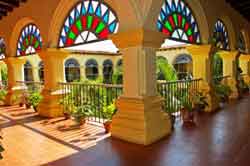Camaguey city and its lights
- Submitted by: admin
- Travel and Tourism
- Arts and Culture
- Camagüey
- Culture and Traditions
- History
- history
- national
- personalities
- Society
- Personalities
- 02 / 25 / 2010

Since early times, the old village Santa María del Puerto del Príncipe had many difficulties in order to accumulate water; nevertheless, neighbors found a clever solution: they produced enormous clay jars, similar to the ones used in Andalusia to
store olive oil.
Old people use to tell a legend about the magic contained in its waters which warns people that whomever who drinks it stays in Camagüey. Nobody knows how much truth there is in the old story but certainly many outsiders, conquered by an unknown
magic, have lived in the region until their last days.
However, there is an element that results into an attraction either to foreigners or locals, even more than its big clay structures: its reach patrimonial architecture.
You can find cobblestone streets, banisters, old roofs showing red tails, squares and alleys every step you made in the Historic Center: a labyrinth of winding streets with almost no trees around, a characteristic that makes of Camagüey a different space from the rest of the other six villages founded by the Spaniards in Cuba in the 16th Century.
PERMANENT ACTION UNTIL 2030
Camagüey City’s Historical Center is considered the largest in the Island; it comprises more than 300 hectares. It preserves attributes and qualities that have acquired a real character of legitimacy.
The strong local sense that distinguishes its architectonic forms and its urban design – determined since the very beginning by a prolonged isolation inland as well as the harmony with the needs and urban dispositions established since its origins – decided an exclusive cultural process that marked the idiosyncrasy of its inhabitants and the enrichment of the environment.
The development plan is permanent –affirms Mrs Pascual- until 2030, and it takes into account the collaboration of many local entities in order to recover the values of buildings with high historic, architectural and cultural values.
Not so long ago, Café Ciudad was finished, a coffee shop on the corner of Martí and Cisneros, which will be part of a complex the includes the city model at the old Collado building, across the street from Parque Agramonte.
Within the investment plan is the future Cultural Anthropology Center, a building of exceptional value taking into account its style, the fine work of its iron bars as well as its mural paintings and frescos.
“The fact that there were Carrara marble floors slowed down the refurbishing process since it was a task never faced before by the Office and we had to assigned a task force made of engineers and architects from Camagüey University and the Historian
Office”, asserted Pascual Wong.
A Cultural Management Center is also being recovered on Calle Independencia.
The project to enhanced main Calle Maceo has already started. It is a joint action including several organizations to underground all electric and hydraulic nets as well as an over all refurbished of all façades and urban spaces to turn this centric commercial street into a beautiful and original boulevard.
These are only part of the works currently going on in Camagüey City to prevail not only for its attractive earthenware jars but also for a well rooted culture and a rich local history preserved through everyday effort.
Source: www.adelante.cu
Comments